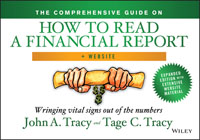
The Comprehensive Guide on How to Read a Financial Report
Tracy, John A.
Tracy, Tage
A comprehensive guide to reading and understanding financial reports Financial reports provide vital information to investors, lenders, and managers. Yet, the financial statements in a financial report seem to be written in a foreign language that only accountants can understand. This comprehensive version of How to Read a Financial Report breaks through that language barrier, clears away the fog, and offers a plain–English user?s guide to financial reports. The book features new information on the move toward separate financial and accounting reporting standards for private companies, the emergence of websites offering financial information, pending changes in the auditor?s report language and what this means to investors, and requirements for XBRL tagging in reporting to the SEC, among other topics. Makes it easy to understand what financial reports really say Updated to include the latest information financial reporting standards and regulatory changes Written by an author team with a combined 50–plus years of experience in financial accounting This comprehensive edition includes an ancillary website containing valuable additional resources With this comprehensive version of How to Read a Financial Report , investors will find everything they need to fully understand the profit, cash flow, and financial condition of any business. INDICE: Preface Part I: Financial Report Fundamentals Chapter 1: Financial Report Basics: The Real Meat and Potatoes of Financial Reports Chapter 2: Starting With Cash Flows Chapter 3: Mastering the Balance Sheet Chapter 4: Understanding Profit Chapter 5: Profit isn’t Everything and All Things Part II: Working Capital Connections Chapter 6: Our Case Study – Company Introductions Chapter 7: Sales Revenue and Trade Accounts Receivable Chapter 8: Cost(s) of Goods Sold Expense and Inventory Chapter 9: Inventory and Accounts Payable Chapter 10: Operating Expenses and Accounts Payable Chapter 11: Accruing Liabilities for Incurred but Unpaid Expenses Chapter 12: Income Tax Expense – A Liability & Asset? Part III: Financial Capital Connections & Cash Flows Chapter 13: Our Case Study – Company Updates & Assessments Chapter 14: Long–Term Assets and Depreciation, Amortization, & Other Expenses Chapter 15: Long–Term Liabilities, Interest, & Other Expenses Chapter 16: Net Income, Retained Earnings, Equity, & Earnings per Share (EPS) Chapter 17: Cash Flow From Operating (Profit–Making) Activities Personal Note From Tage: Chapter 18: Cash Flows From Investing and Financing Activities Part IV: Financial Report Analysis Chapter 19: Expansion and Contraction Impacts on Cash Flow Chapter 20: What is EBITDA and Why is it Important Chapter 21: Financial Statement Footnotes – The Devil’s in the Detail Chapter 22: Financial Statement Ratios – Calculating & Understanding Chapter 23: Profit Analysis for Business Managers Chapter 24: Our Case Study & The Moral of the Story – The Good, the Bad, & The Ugly Part V: Financial Report Truthfulness Chapter 25: Choosing Accounting Methods and Massaging the Numbers Chapter 26: Audits of Financial Reports Chapter 27: Small Business Financial Reporting Chapter 28: Basic Questions; Basic Answers, No BS About the Companion Website Index
- ISBN: 978-1-118-73571-8
- Editorial: John Wiley & Sons
- Encuadernacion: Cartoné
- Páginas: 352
- Fecha Publicación: 19/02/2014
- Nº Volúmenes: 1
- Idioma: Inglés
